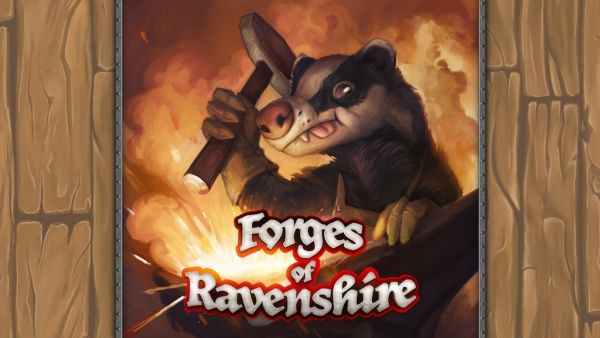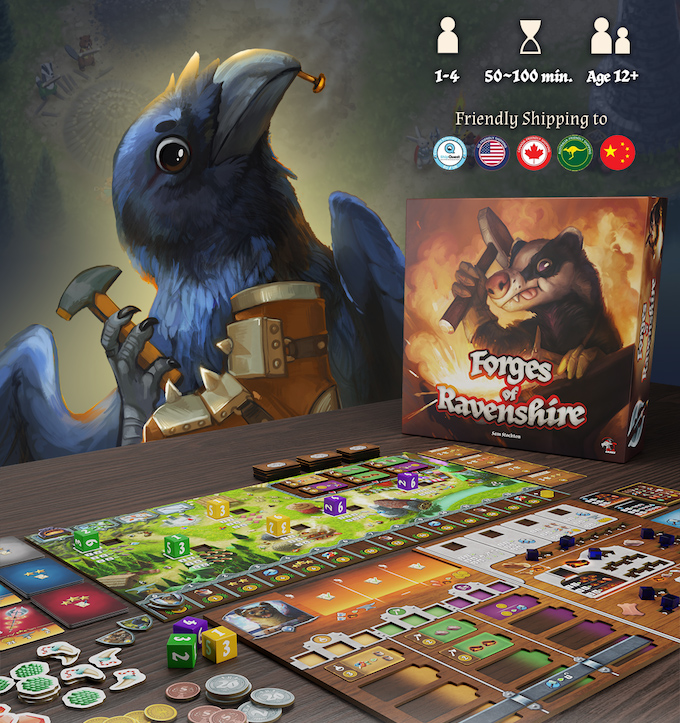Preview: Compete to be the Best Blacksmith in Forges of Ravenshire

Designer Sam Stockton challenges players to become the fiercest anthropomorphic forge master in this engine-builder combo fest which leverages dice actions to get the most money out of one’s forge to become the victor.
Gameplay
Forges of Ravenshire revolves around two boards: the central board, where everyone will be placing and taking dice, and individual player boards where much of the action transpires. This is done through the game’s three phases conducted over four rounds: Gathering, Production, and End of Round.
Set up involves rolling six dice (two green Harvester, two yellow Alchemist, and two purple Merchant guild dice) and placing them in the appropriate slots on the board. Guild tokens will be shuffled and placed on the board where indicated. A number of Tile Tokens depicting extra goals to fulfill will also be shuffled and placed beside the board (dependent on player count) and money and mystic tokens will be placed in communal areas so everyone can access them. The contract decks (separated into three piles of levels 1-3 contracts) are shuffled, and three of each level are placed face-up.
Players will choose one of the player boards, each denoting a different could-be forge master, and claim the appropriate player tokens and overtime cards (allowing players to take additional actions at the cost of action tokens). Players will also take one of each type of die, four coins, and one action token. Players will use their cubes to denote their starting Ore, Charcoal, Steel, Leather, and Wool of one each. Finally, players will roll their dice and place them to the side of their board. The highest total will be the first player.
The totals of the dice are important during the Gathering phase, for they will determine what players will receive as they place their dice on the board. When placing, all that matters is the total. Place any color die in any empty slot and gain the goods from that section, which could be a set number of goods (such as ore or wool), mystic tokens, or Guild tokens. If you earn a Guild token, you must pay the cost shown on the lower left side and may then place it on your board in the appropriate area.
After placing a die, players will then choose one of the dice from the central board (not the one just placed) to take and place on their player board. This is where both color and value will matter because the die will be placed in one of the matching guild slots and players will then be able to run that guild, gaining what is shown on the Guild tokens in that column. Players will have up to three open slots per guild available, with an opportunity to unlock the fourth for all guilds by spending action tokens. The value of the die does not affect what is earned in the Guild but will be important in the next phase of the turn. Players will play all their dice and take 3 dice during the Gathering Phase
During the Production phase, players will perform up to three tasks. The first will be moving the dice they gathered and put into their Guilds over to the right side of the board, where the value of the die placed in a space will correspond with what will be gained. In the top four spaces, players are able to run a guild again (ignoring the die color), gaining more action tokens, which allow players to take bonus actions during each phase, or gain additional goods of a player’s choosing. Players may also choose to place their dice Charcoal Kiln or Steel Foundry to gain the amount of goods (and perhaps mystic goods). Players can choose to upgrade these areas as well for greater benefits.
Players may also fulfill contracts on display if they meet the requirements. The top left of the card will show what is needed (and the quantities) to fulfill a contract. The bottom of the card will show what is gained by the player in completing the contract, such as gold, other goods, or mystic goods. There are also benefits for not only just meeting the contract’s necessities but giving it a special finish. By spending two Mithril and a Charcoal (Mithril finish), players will gain an extra reputation for completing the contract. An Embergem Finish costs two Embergems and one Charcoal and will gain players an additional 4 gold for completing the contract. Depending on which finish a player chooses (including no finish), the card will be slotted in the appropriate area on their player board.
At the beginning of the game, players may only complete Level 1 contracts. However, as they gain reputation by completing contracts or earning it through a Mithril Finish or gaining it via Production on their player boards, Levels 2 and 3 contracts will become available. As players continue to advance up the reputation track, they’ll also earn goods and gold that will help them.
Finally, the End of Round phase occurs. Players will check to see if they’ve fulfilled any of the requirements of the displayed Tile Tokens, with anyone meeting the requirements earning the amount of gold shown on the bottom of the tile. It is then turned face-down because it cannot be claimed again. Multiple players can claim a Tile Token at the same time, and players can claim multiple Tile Token benefits in the same round. The first player will refresh the main board by collecting the six dice, rolling them, and placing them starting from the far left of the main board until all areas have one die. The Guild tiles on the main board are refreshed, with any from the bottom row removed, the top row moved down, and the top row replenished from the face-down stack. The first player token moves to the left, players roll the three dice from their boards and play continues.
After the fourth round, players will tally the number of gold they have earned, plus where they finished on the Reputation track. Players may also use the Market Exchange to trade in the requisite amount of goods to gain gold. Action tokens not used will also count as 1 gold each. Tally all these sources, and the players with the most in the new Forgemaster of Ravenshire. In case of a tie, the furthest along on the Reputation track is the winner, with completed contracts and then the amount of goods breaking any continued ties.

Forges of Ravenshire (image provided by the publisher)
Review
Despite the myriad actions during each phase of the game, Forges of Ravenshire is a game that players will understand midway through their first turn. At it’s heart, it’s a clever blend of engine building and action selection by simply rolling and using dice.
Though dice are involved, luck is often not a factor because high, low, and in-between rolls can all provide benefits. It becomes a matter of what your particular engine may require for getting the goods, Reputation, or Mystics required to continue rolling along and how other players’ choices may hinder that engine.
Speaking of player interaction, it’s often indirect but nonetheless integral. Again, paying enough attention to the dice other players may be looking to collect from the main board to run their Guilds or improve their Production may hamper your own abilities to maximize phases during a turn. It’s also wise to pay attention to the types of contracts other players are fulfilling because they may swoop in and take the bonus of a Tile Token you are working toward, so it’s critical to not get frozen out if another player completes it before you’re ready to collect on it.
It may feel that there is much to juggle in Forges of Ravenshire, but it’s really a tight engine builder that rarely allows players to run away with a victory. The use of Overtime cards and Action tokens to allow added value to their turns is also a satisfying part of one’s engine, learning when to best leverage each to their greatest benefit.
This is where some may feel that Forges of Ravenshire is too much for them. Players who suffer from analysis paralysis (AP) or are keen to min-max their gaming experiences will find plenty of those opportunities within any given game. Yet, there is so much to love for players who are not prone to these whims. The game also includes Assistant Cards, which players can use to make the game a bit more advanced and involved once they get the handle on it that helps eliminate some AP but may only embolden the min-max players in your group or household.
Don’t let this one minor quip about the gameplay of others detract from a game that, even in prototype form, really hits the mark on design. Sam Stockon’s ability to create a game that has much going on but is easy to pick up and play once rules are learned cannot be ignored. Similarly, the art of Andrea Radeck and Liam Peters, as well as graphic design from Julian Tunni/Art Potions, bridge the fun of anthropomorphic animals with a bit of fantasy-based realism in the tones of colors of Ravenshire’s atmosphere.
Forges of Ravenshire is currently on Kickstarter.
Pros: Engaging engine builder combining with rich action selection choices; Great blend of art and graphic design choices to put players into Ravenshire’s world
Cons: Game is prone to AP and min-max players slowing down the action
Disclosure: This is a paid preview based on our evaluation of an unpublished prototype of this game, which is subject to change prior to publication.




